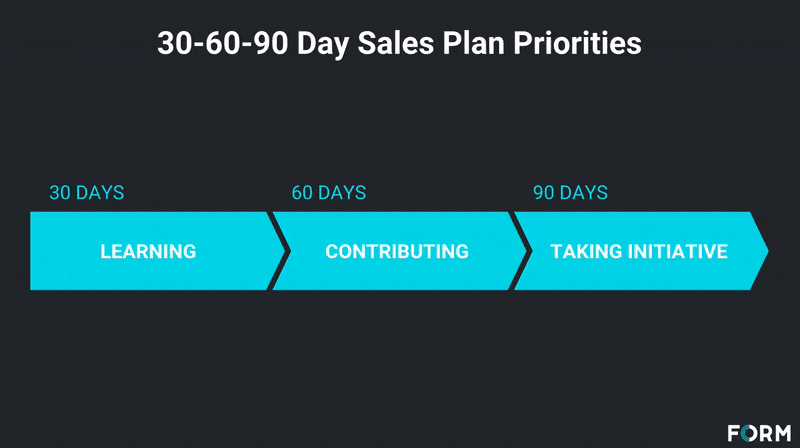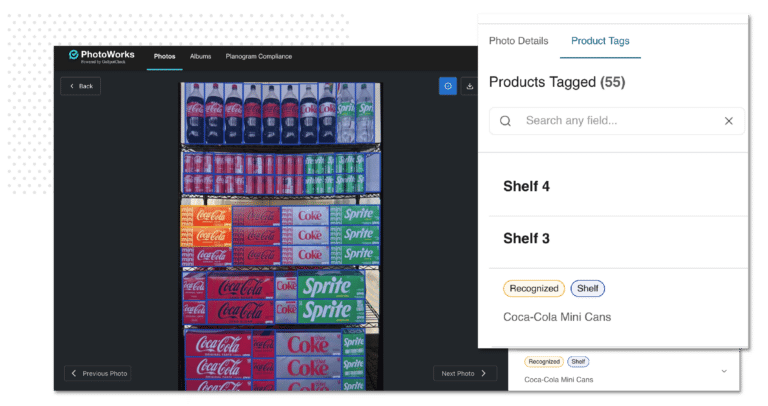30-60-90 Sales Plan Template
Starting a new job as a sales manager can be overwhelming: In between onboarding and getting to know your direct reports, you need to familiarize yourself with company tools and technology, marketing operations, and sales goals and metrics. To set themselves up for success, many sales managers rely on a 30-60-90 day plan to help them create and prioritize objectives, set clear expectations and accountability, and maximize output.
Read on to discover how sales managers and teams can create a three-month sales plan to ensure success in their new role.
What is a 30-60-90 Sales Plan?
A 30-60-90 sales plan is a general framework that outlines a new employee’s goals for their first three months on the job. It clearly defines targets and creates alignment between sales reps, directors, hiring managers, and other teams, ensuring that everyone is on the same track to success.
30-60-90 day plans are typically developed for new hires—either during the job interview process with the hiring manager or their first week on the job, but can also be used for more tenured sales reps if they are moving to a new territory or selling a new product or solution. The main objectives are self-management, clear expectations, and alignment with business plans month by month.
Craig Ferrera, Director of Business Development at FORM, uses a goal-based framework similar to 30-60-90 to motivate his BDRs personally and professionally. “Improvement seems like a daunting task,” he says, “but setting incremental benchmarks and focusing on micro-improvement makes it much more achievable. It’s not about reaching all your goals on day 1; it’s about what small improvements you can make each day to get you closer to your goals.”
Key Components of An Effective Three-Month Sales Plan
As a sales manager, before going into the smaller details that your 30-60-90 day plan will have, you’ll want to think about what to think about the high-level elements that it should include. Consider the following when creating your plan:
Use SMART Goals
In each stage of your strategy plan, your goals should be SMART: specific, measurable, attainable, realistic, and time-bound. For example, instead of saying, “Learn more about our target accounts,” a SMART goal would be, “Within the first two months, identify our top 10 target accounts and reach out to half of them.” SMART goals allow everyone to be on the same page and offer visibility into goal progress.
Take Company Objectives Into Account
When creating your 30-60-90 day plan, always consider the objectives of the broader team and the company as a whole. In fact, one of the first items in your plan should be to understand the company’s current goals and priorities and align your own objectives with those.
Includes Personal Goals
In addition to performance goals, a strong 30-60-90 strategy will include personal goals, as well. Whether you want to develop your professional skills, build strong relationships with key stakeholders, or join a workplace committee or club, defining your personal goals will create a more in-depth plan.
“While many of our metrics are centered around getting leads and booking meetings,” Ferrera says, “I always encourage the team to carve out time for personal development, as well. I want them to be empowered to read a book or check out a webinar to gain valuable knowledge.”
Keep it Short and Sweet
Listing out goals for three months may seem daunting, but keeping it short and simple will make it more successful in the long run. Your 30-60-90 day plan should be skimmable and no more than one or two pages long.

30-60-90 Day Plan Template
First 30 Days
Your first month should be focused on learning. You’ll want to get up to speed on your new role, your sales team, and your new company as a whole. You’ll need to familiarize yourself with the team’s immediate and long-term priorities and the responsibilities of yourself and your direct reports.
It’s also important to learn as much as you can about the product or solution you’re selling during your first 30 days. Watch sales training videos or past presentations, read through the website and sales documents, and review competitor websites.
“This is when you get a holistic lay of the land,” Ferrera shares. “Especially as a manager, it’s important to really take the time to get to know your team. Gather an honest assessment from them about what’s currently working and what isn’t. Even though you’ll eventually be leading them, in the beginning, you’re there to learn as much from them just as they’ll be learning from you.”
While every sales role may be slightly different, by the end of your first 30 days you should have:
- Completed the onboarding process and have access to all the tools and accounts used for sales (email, CRM software, sales management platform, etc).
- Learned the high-level priorities for yourself, your team, and the company
- Acquired a base-line knowledge of key products and services and understand your position in the market as well as competitors
- Established relationships with co-workers throughout the organization, including account management and customer success
- Immersed yourself in key internal documents and assets
First 60 Days
The second month in a new job should be focused on contributing. Now that you are beginning to feel more comfortable with the role and the company, you can begin to explore how you can actively make an impact on sales and strategy. You should now understand your products and the marketplace more comprehensively and begin to forge connections with prospects and potential partners.
“As a Business Development Representative, the first 30 days are all about activity,” Ferrera says. “After a new hire learns the company and the product, we look at pure activity—how many calls or emails are they engaging in weekly. By day 60, we begin to look at effectiveness. How effective is our team in getting prospects on the phone?”
A few goals by the end of day 60 may include:
- Deepen relationships and build further trust with your team
- Observe a more experienced member of the sales team by sitting in on calls
- Identify 10 prospects and schedule 5 meetings
- Fully understand and begin to utilize the internal sales tracking system
- Arrange a check-in with your manager to discuss goal progress and feedback
- Schedule coffee or lunch with a team member you haven’t gotten to know yet
First 90 Days
The focus of your 61-90 day strategy should be taking initiative. You should be completely familiar with your role, the company’s processes and KPIs, and begin to emerge as a trusted sales leader. At this point, you should have established your personal selling strategy and have your foot in the door with multiple strong prospects and high-quality leads, and, depending on how long the sales cycle is, maybe even closed a deal or two.
Other benchmarks of your 90-day plan may include:
- Created credibility and a trustworthy environment amongst your team
- Led a sales meeting or shared performance report with key stakeholders
- Established a daily schedule for yourself and your team
- Spearheaded a new project or initiative to increase output
- Followed up with feedback given by peers or superiors
- Measured progress against your original 30-60-90 day plan
Looking Ahead
While an exact 30-60-90 day plan may not work for every sales role, it’s important to begin a new job with learning goals, performance goals, and personal goals. After three months of working on these objectives, you should be confident and comfortable in your role. You may not be a seasoned expert, but you should be forging relationships, delivering results, and solidifying your place as a valuable team member.
Ready to learn more professional growth strategies and other industry insights? Follow FORM on LinkedIn.




